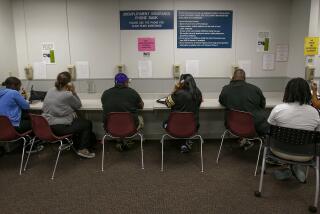Wages up; output gauge flat
- Share via
WASHINGTON — Growth in productivity -- the key ingredient for rising living standards -- skidded to a standstill in the late summer while workers’ wages and benefits shot up at the fastest clip in more than two decades, according to data released Thursday.
The combination of slowing productivity and rising wages was seen as a formula for inflation troubles down the road. It could keep the Federal Reserve from cutting interest rates any time soon and possibly lead to another increase.
Productivity, the amount of output per hour of work, showed no growth from July through September. Growth was just 1.3% over the last 12 months, the weakest showing in nine years.
The cost of wages and benefits measured by each unit of output grew at an annual rate of 3.8% in the third quarter.
Employee compensation climbed 5.3% over the last year. That gain was the fastest since a 5.8% rise in the 12 months ended in the fourth quarter of 1982.
Higher wages and benefits are good news for workers. But such increases can trigger inflation if companies pass on the higher wage costs by making products more expensive.
Rising productivity allows companies to pay their workers more from the increased production rather than having to finance the wage hikes through price increases.
“If rising unit labor costs are passed on in higher prices, that would mean stubbornly high inflation and no rate cuts from the Fed,” said Nigel Gault, a senior economist at Global Insight Inc.
Companies could pay the higher salaries from their profit margins, but that would mean smaller returns for shareholders.
After 1995, the U.S. enjoyed a decade of strong gains in productivity. But as the economy has slowed this year, productivity has slowed too even as unit labor costs have risen 3% or more in each of the last five quarters.
In other economic news, orders to U.S. factories for manufactured goods rose 2.1% in September. Although that was the biggest increase in six months, it was heavily influenced by a huge surge in demand for commercial aircraft. Outside of transportation, factory orders fell 2.4%.
The Labor Department said the number of workers filing new claims for jobless benefits rose by 18,000 to 327,000. This was the highest level of weekly claims since the week of July 8, when there were 334,000.
More to Read
Inside the business of entertainment
The Wide Shot brings you news, analysis and insights on everything from streaming wars to production — and what it all means for the future.
You may occasionally receive promotional content from the Los Angeles Times.










